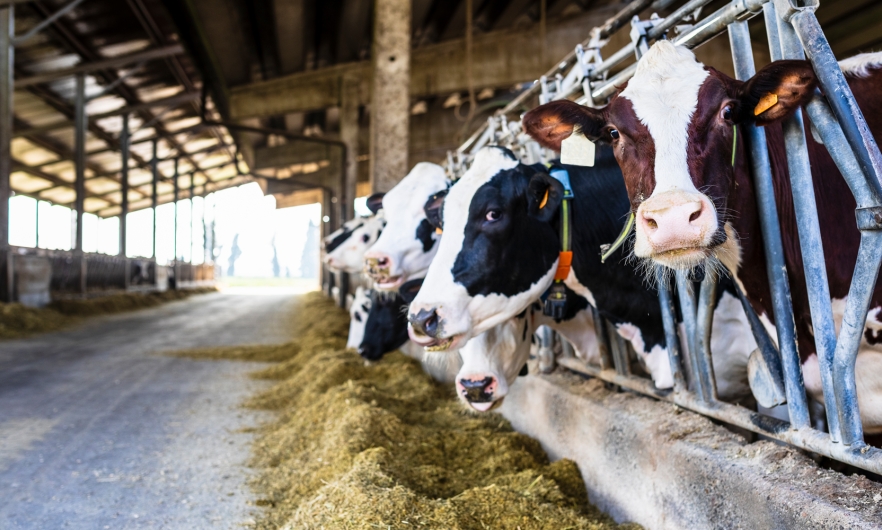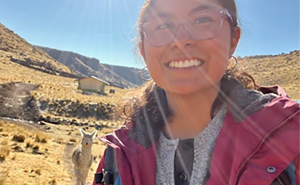What’s Happening With Dairy Cows and Bird Flu
Though the virus is circulating in dairy cows, human exposure remains low.

Editor’s note: This article was updated on April 10, 2024.
The H5N1 strain of avian influenza—commonly known as bird flu—has been circulating among wild migratory birds for the past two years, with substantial spillover into poultry farms.
But what's sparking concern among scientists and public health officials alike is the recent discovery of the virus in dairy cows and the subsequent infection of a dairy farm employee—the second person in America ever documented to be infected with H5N1. The virus has now spread to 16 herds in six states according to the USDA, fueling concerns about potential further transmission to humans.
In this Q&A, adapted from the April 8 episode of Public Health On Call, Stephanie Desmon speaks with Meghan Davis, DVM, PhD ’12, MPH ’08, associate professor in Environmental Health and Engineering, and Andrew Pekosz, PhD, professor in Molecular Microbiology and Immunology, about H5N1’s jump between species, what that means for the virus’s pandemic potential, and what the appearance of the virus in dairy means for consumers.
What’s going on with the avian flu?
AP: This virus has been around for over 20 years. It's been mutating over time, and something happened in the last couple of years to cause an explosion of cases in wild birds. Not surprisingly, that's led to spillover infections in some poultry farms. There's also been an increase in mammals that have been infected, such as skunks, bears, and foxes, presumably from feeding on dead infected birds. And recently, we've seen spillover of this virus into dairy cows.
Cattle have not been reported to be infected with any of the influenza A viruses—human or animal—to date. Anytime this virus enters a new host, we set off some alarm bells in the scientific community to see what's going on.
Can we expect to see more cases in humans?
AP: I expect that over the next few weeks, we're going to be seeing more cases in cows and humans, because humans are in close contact with cows during many dairy processes. Hopefully, this will not be a large outbreak, but we certainly expect to see more cases.
Were you surprised by this outbreak?
MD: I am surprised that it's in dairy cows, because when we think about animal models for influenza, we think about mustelids, like ferrets or mink. We have also seen a number of sick farm cats that tested positive. What is most interesting about seeing [H5N1] in dairy is that researchers haven't been focusing on biosecurity and biocontainment for things like avian influenza—which is typically transmitted from a bird reservoir. Dairy farms are often quite open to the air—birds might spend time in areas where the cows eat, for example.
One of the other things we are seeing is some symptoms of disease in the cows. I've not heard of high mortality yet, but they have been showing fairly nonspecific signs, like not eating or milking well. Most of these tend to be somewhat older cows because adult cows who are lactating are in a different category of susceptibility than young calves. What we don't know yet is if perhaps the virus is in all the populations within the farm, and only some of them are showing symptoms.
Is the milk they produce safe for consumption?
MD: For the average person buying commercial milk, we don't have any evidence that would suggest concern. If you buy pasteurized milk from a commercial dairy processor, the risk is extremely low. Pasteurization, which involves temperature and pressure and time, is designed to inactivate microbes to make the milk safer to consume and to give it longer shelf life. I strongly advise against consuming raw milk products, no matter where you live, because there are other risks, not just avian influenza.
What can the surveillance data from infected cows tell us?
AP: Two things are really important. One is: The virus has gone from the respiratory tract through lots of different organs, through the blood, and made it all the way to the milk. In humans, the influenza virus stays within the respiratory tract. We have seen H5N1 move out of the respiratory tract in other animals, but usually that's associated with a really fast mortality. As soon as the virus leaves the lungs, the animals are so sick that they die. We're seeing a case here where the animals don't seem to be really sick, but the virus is making it to other parts of the animal. That's going to tell us something perhaps unique about the H5N1 virus compared to seasonal human viruses.
The second critical thing is: If there is spread of this virus from cow to cow, is the virus changing and getting better adapted to replicating or spreading in cows? Bird flu jumping to mammals is important because anything that allows the virus to adapt to a mammal has the potential for making it better able to infect humans. Understanding what happens now with the spread of the virus and how the sequence of the virus changes is going to be critically important. The first sequences [from cows] look like the virus is almost identical to the bird virus. But we haven't really sampled animals that presumably acquired the infection from other cows.
If it's spreading from cow to cow, is that a wholly different problem?
MD: There is a lot of swapping of cows in the dairy industry, and there is a diverse population of farmers, each of them has their own way of doing things. And that means that we may need to educate farmers about perhaps restricting certain sales or trade of dairy cows if evidence shows that you could introduce avian flu through a cow brought in from outside the farm.
The USDA has released recommendations for state animal health officials, veterinarians, and producers, including trying to exclude birds and cats from areas where livestock are kept, not moving sick or exposed cows, using PPE among workers with exposure to dairy cows, and other measures.
Something I'm very interested in is: Where were each of these cows exposed? To what degree was this one event that is now spreading through these networks of sale and trade and movement of dairy cows? Or is this multiple events in which you've had an introduction [of the virus] from birds? Because that also changes the dynamics as we think about genetics and the potential for evolution.
AP: It’s also clear that the USDA has not ruled out that spread from cow to cow is happening via contaminated milking equipment because the amount of virus in the milk is much greater than what is found in the nose of infected cows. If this is contributing to virus spread, it should be straightforward to institute equipment disinfection protocols that could slow or stop virus spread.
Is H5N1 considered a major threat at this time?
AP: H5N1 registers as what we call “a virus with pandemic potential.” Humans presumably all have some immunity to H1 and H3 influenza viruses, which can cause seasonal epidemics, but they can't cause pandemics at the level of what we saw with COVID because there's just too much immunity in the population that limits the spread and dampens down disease severity.
However, the human population is essentially completely naive—has no preexisting immunity—to H5 viruses. Therefore, similar to what we saw with COVID, in the worst case scenario, if this virus enters humans and starts to spread, all of us are susceptible, and we could see massive increases in numbers of cases.
H5 viruses are rather deadly in poultry. They're not so deadly in wild birds, but they seem to be deadly in mammals, and we don't know what they'll do in humans.
MD: Right now, the average person should just be aware and avoid things like raw milk products. However, because we are seeing the potential for disease in cats, and we don't know yet if that came from cows or birds or some other pathway—it's a good idea to prevent your cats from having contact with wild birds. If they're indoors, keep them indoors, and if they become ill, consult your veterinarian.
This interview was edited for length and clarity by Morgan Coulson, an editorial associate in the Office of External Affairs at the Johns Hopkins Bloomberg School of Public Health.
RELATED:
More from the Bloomberg School
- See latest headlines
- Learn more about our departments:





